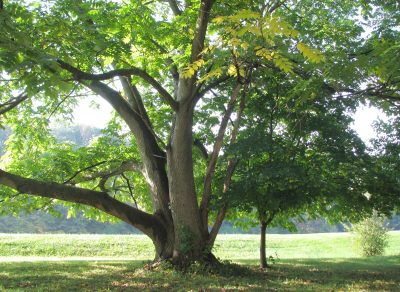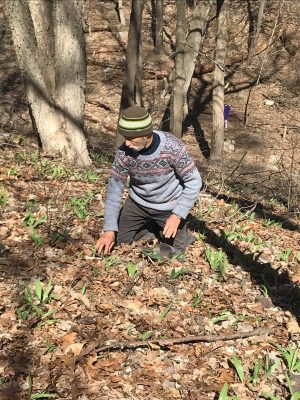I MAKE TREES
Here are 3 Easy, Fun Grafts I Made Yesterday
Finally, the weather cooperated and I got around to doing some grafting. I could have done it a couple of weeks ago, as I had planned, but I’m blaming cooler weather for the delay. Not that I couldn’t have done it back then, but things chug along more quickly in warmer weather, so I waited.
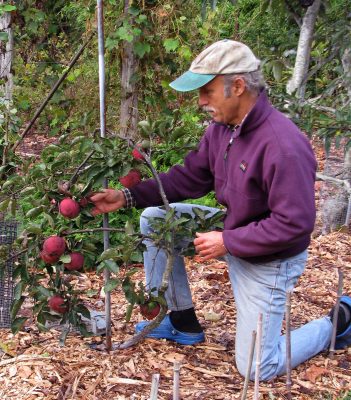
Apple tree on very dwarfing rootstock
I’m going to describe 3 easy grafts I did yesterday. Which one I chose to do depended on the size of the rootstock on which I was grafting. The scions, which are the varieties I’m grafting on the rootstocks, are all one-year-old stems 6 to 12 inches long and more or less pencil-thick (remember what pencils are?). They have been stored, wrapped to prevent drying out, in the refrigerator so that they are more asleep than the awakening rootstocks.
The principles that make any graft work are all the same. Close kinship of stock and scion. Close proximity of the cambium — the layer just beneath the bark — of the stock and of the scion. All open wounds sealed against moisture loss. And immobilization of rootstock and scion until graft succeeds. My book, The Ever Curious Gardener: Using a Little Natural Science for a Much Better Garden, goes into more detail about the why and the how of grafting.
A Tree Make Over
For starters, I turned to the bark graft, good for grafting on rootstocks a couple or more inches across. This first graft was on a Tyson pear tree whose flavor wasn’t up to snuff, so that graft began with doing a Henry the Eighth, lopping off the tree’s head to graft height, which was a couple feet from ground level.
The bark graft comes with an good insurance policy. That’s because onto each rootstock, depending on its diameter, I can stick 3, 4, 5, or even more scions. Only one scion needs to grow, but the more that are grafted, the greater the chance of at least one growing.
I prepared a scion with a bevel cut 2 inches long, at its base, not quite all the way across from one side to the other. On the opposite side of the cut, I nicked off a short bevel.

Then, into the freshly cut stub on the rootstock, I made two vertical slits through the bark, each about 2 inches long and as far apart as the width of the base of the scion.
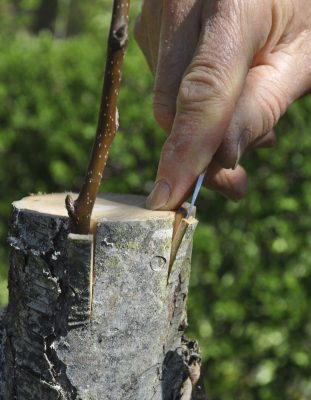
Carefully peeling back the flap of bark welcomed in the long, cut surface of the scion, putting the cambial layers of rootstock and scion in close contact. This was repeated with the other scions, all around the stub. With the peeled back flaps of bark from the rootstock pushed back up against each inserted scion, one or two staples from a staple gun or a tight wrapping with stretchy electrician’s tape sufficed to hold everything in place.
Finally, I sealed all cut surfaces against moisture loss, for which there are a number of home-made and commercial products. My favorite is a commercial product called Tree-Kote, a black goo that works really well and absorbs sunlight.
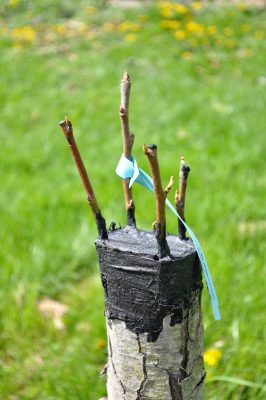
Another Tree Make Over, For Smaller Trunks
For smaller rootstocks, say 3/4 inch up to a couple of inches across, there’s the cleft graft. This also comes with an insurance policy, though not as good as that of the bark graft because it only gets two scions per graft. Still, it’s easy so chances for success are high.
At the base of each of the two scions, I made two bevel cuts less than halfway through, each two inches long and not exactly on opposite sides. Viewed head on and from below, the uncut portion was slightly wedge-shaped.
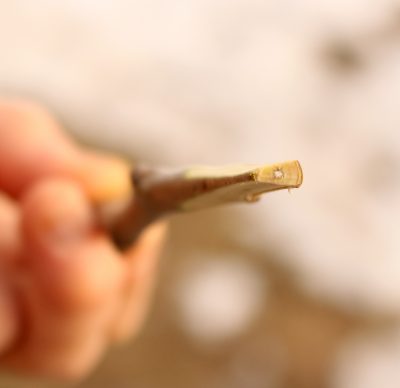
Turning to the rootstock, an older rootstock (OH x F 87), I lopped it off squarely, with a saw, then created a split a couple of inches deep in the middle of the cut surface by hammering a heavy, sharp knife right down into it. After removing the knife, a screwdriver pushed down into the split separated it enough to insert the two prepared scions at each edge of the cleft with their cambiums aligned with the cambium of the rootstock.
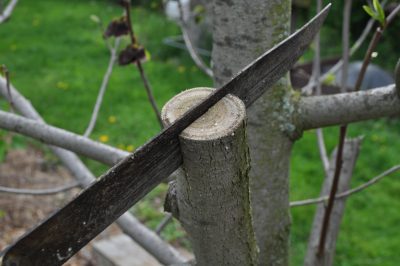
Pulling out the screwdriver caused the springiness of the rootstock to close the cleft and hold the scions securely in place. As with the bark graft, all cut surfaces got smeared with Tree-Kote.
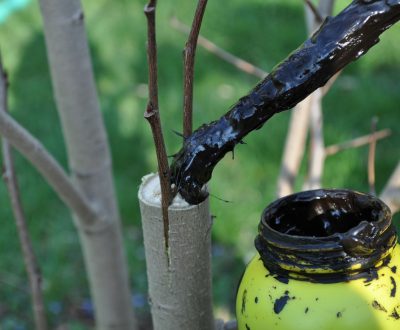
And Some Baby Tree Grafts
The whip graft is my graft of choice when rootstock and scion are about the same thickness, pencil-thick. Rootstocks for whip grafts were again OH x F87 pears, this time one-year-old rootstocks, pencil-thick.
I cut at the bottom of the scion with a smooth, sloping cut an inch to an inch and a half long, and made a similar cut at the top of the rootstock.

Holding the sloping cuts against each other and aligning just one edge of each if their diameters didn’t exactly match, I bound rootstock and scion together with a rubber grafting strip. (I’ve also used thick rubber bands, sliced open.)
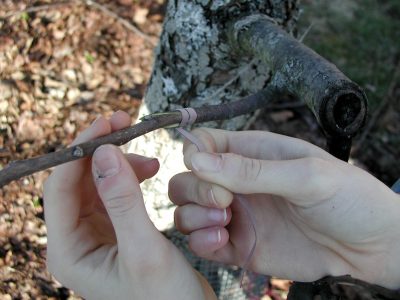
Wrapping whip graft
As with any graft, cut surfaces must be sealed against moisture loss. Parafilm® helps holds the graft together and seals in moisture. Once my whip graft scions are growing strongly, I’ll cut a vertical slit into the binding to prevent it from choking the plant.

Bark graft, season 3, note flowering
There you have it: 3 easy grafts to make new trees or make over an older tree. Now the excitement begins, watching and waiting for new growth. Sometimes, with that large root system fueling growth, a bark graft scion will grow 2 or 3 feet its first season!

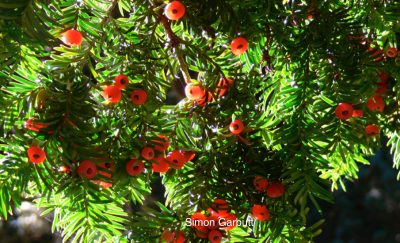
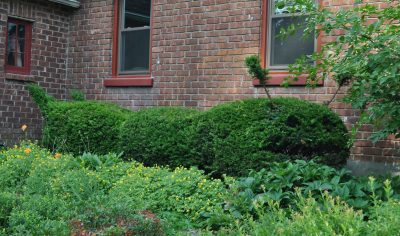

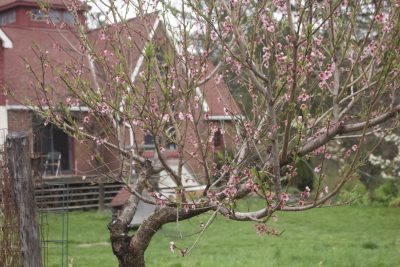
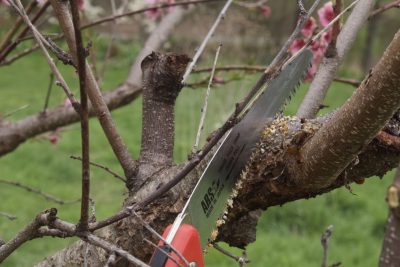 major cuts aimed at keeping the tree open to light and air.
major cuts aimed at keeping the tree open to light and air.
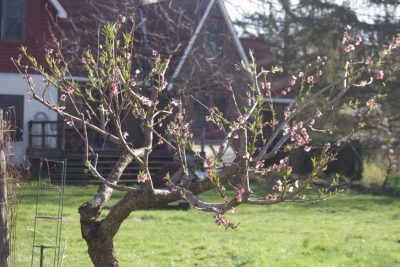 And, of course, for more about pruning, there’s my book,
And, of course, for more about pruning, there’s my book, 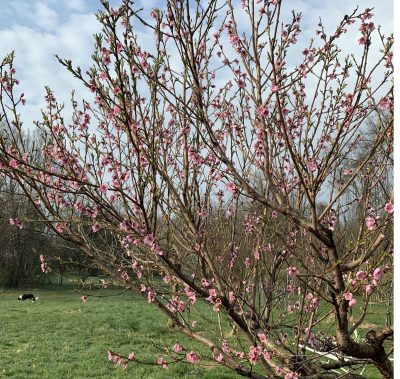
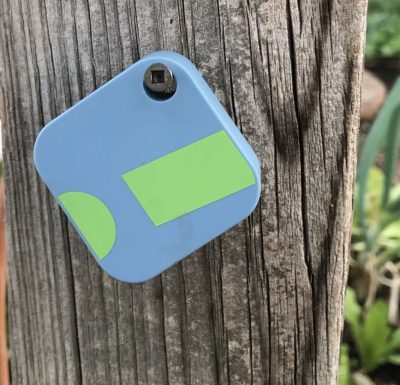 Great. Even better, temperature (as well as humidity) is recorded, and can be displayed graphically or downloaded to my computer. So I didn’t have to be awake to find out the mercury hit 32.5°F at 12:16 AM on the night of April 17th and stayed there until it began rising around 7 AM.
Great. Even better, temperature (as well as humidity) is recorded, and can be displayed graphically or downloaded to my computer. So I didn’t have to be awake to find out the mercury hit 32.5°F at 12:16 AM on the night of April 17th and stayed there until it began rising around 7 AM.

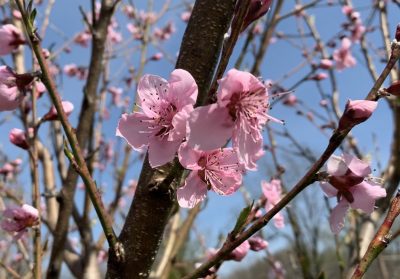
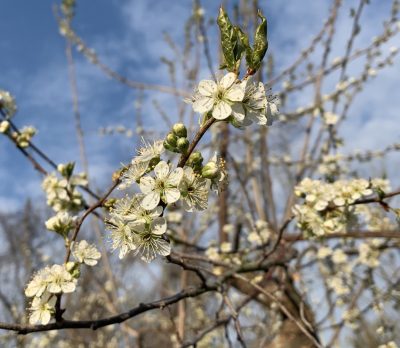
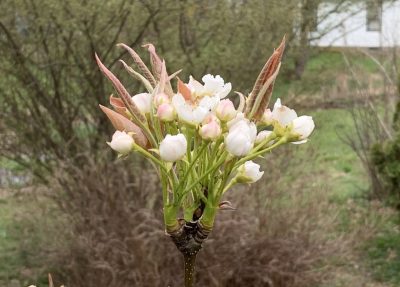
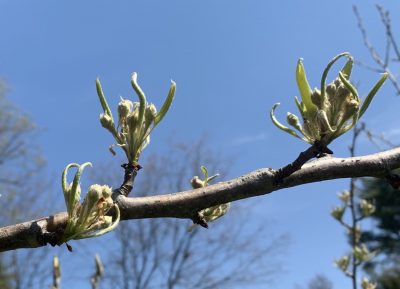

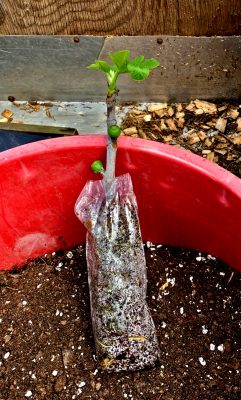

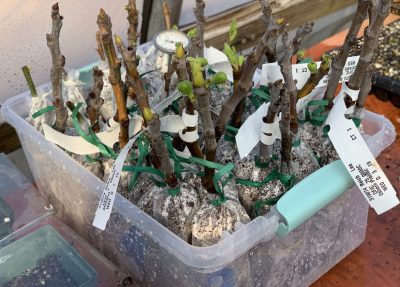 No light is needed until cuttings start to leaf out. Which is an exciting moment, because roots might — or might not — begin to show about then. All that’s needed is to lift a fig pop and take a look. Some of mine showed roots after only 3 weeks! But it’s good to let them get well rooted before disturbing them.
No light is needed until cuttings start to leaf out. Which is an exciting moment, because roots might — or might not — begin to show about then. All that’s needed is to lift a fig pop and take a look. Some of mine showed roots after only 3 weeks! But it’s good to let them get well rooted before disturbing them.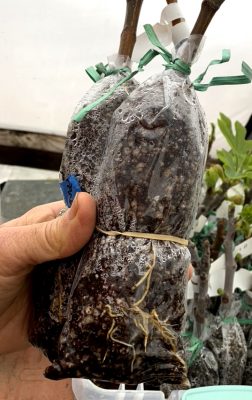



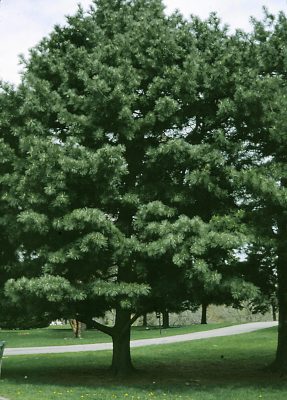
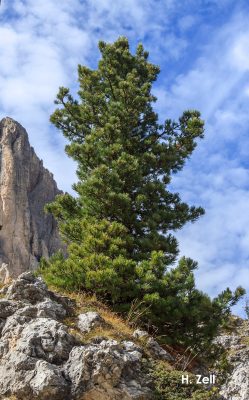
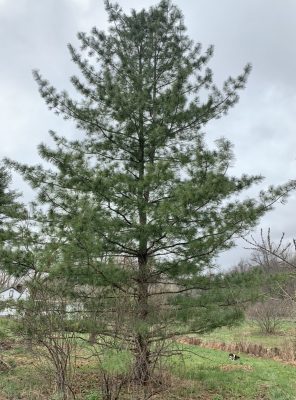
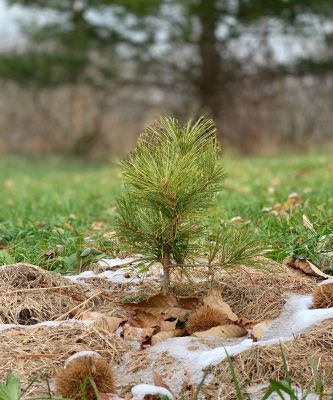

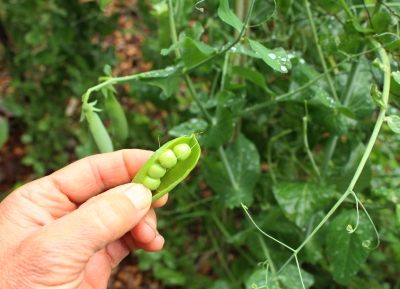
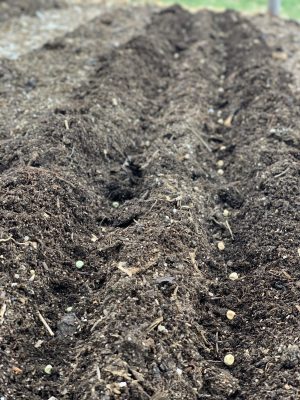
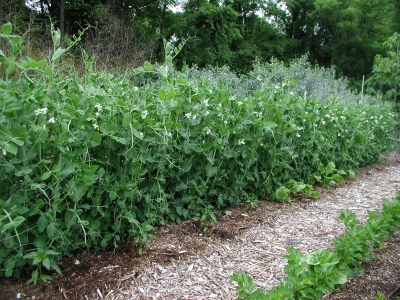

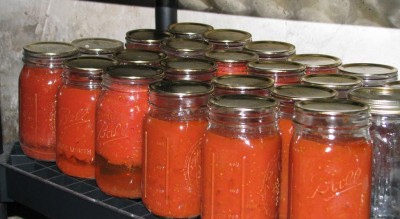
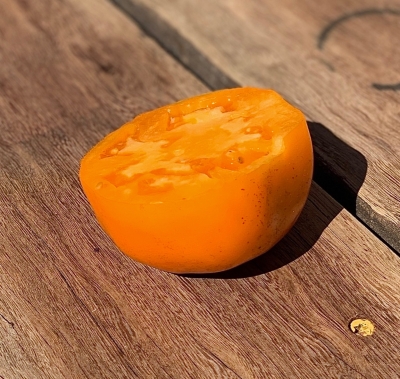
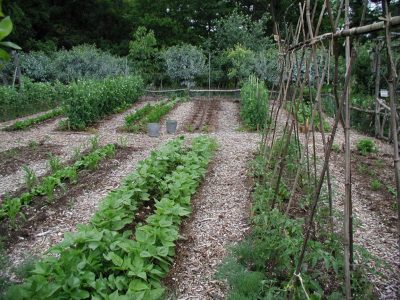
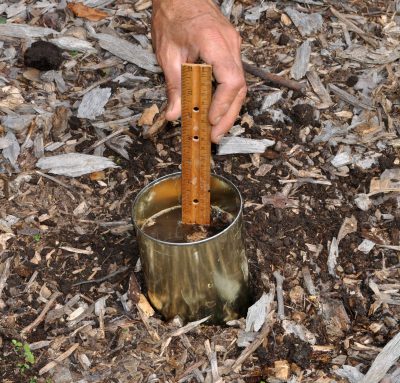
 Wait two weeks for Mother Nature to work her magic decomposing some of that existing vegetation. Or, rather, part of her magic. After two weeks, dig up the ground again, this time adding some compost or fertilizer. You could dispense with the compost or fertilizer this season if whatever was growing there before digging looked vibrant. Better not to go out to a store these days if you don’t have to anyway. Wait another two weeks, and when you’re ready to plant, use a garden rake to tickle the surface of the ground and crumble it.
Wait two weeks for Mother Nature to work her magic decomposing some of that existing vegetation. Or, rather, part of her magic. After two weeks, dig up the ground again, this time adding some compost or fertilizer. You could dispense with the compost or fertilizer this season if whatever was growing there before digging looked vibrant. Better not to go out to a store these days if you don’t have to anyway. Wait another two weeks, and when you’re ready to plant, use a garden rake to tickle the surface of the ground and crumble it.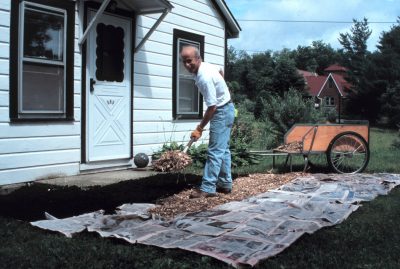
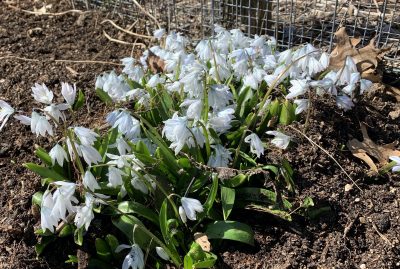 Busy, such as: attending to my compost. The last compost pile of late fall and winter is an accumulation of end-of-season debris from garden cleanup, bedding from the duck house, and kitchen scraps. Not much happens in it with the slow additions and winter cold. I decided to dig into the pile to see how it was doing. Not good!
Busy, such as: attending to my compost. The last compost pile of late fall and winter is an accumulation of end-of-season debris from garden cleanup, bedding from the duck house, and kitchen scraps. Not much happens in it with the slow additions and winter cold. I decided to dig into the pile to see how it was doing. Not good!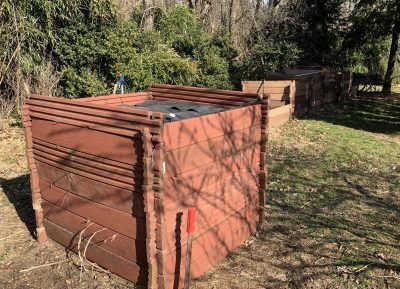
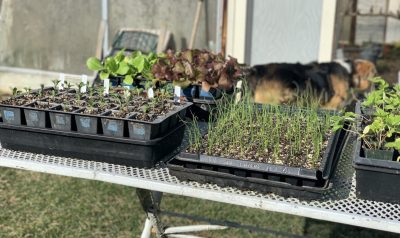
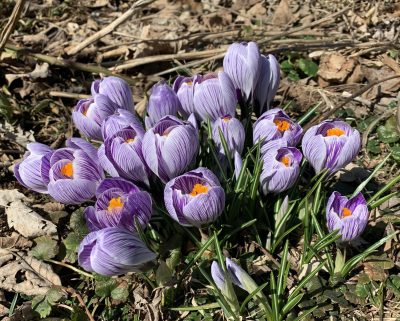
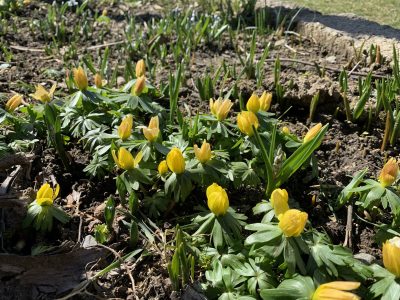
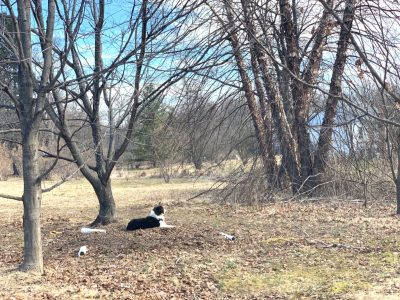
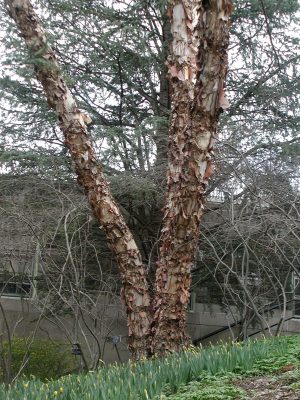
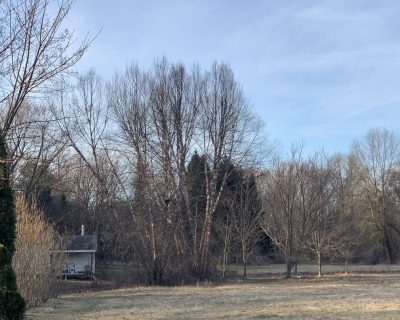 I also planted a white oak (Quercus alba), whose sturdy limbs, I figured, would slowly spread wide with grandeur in about 150 years, after the maples and birches were perhaps long gone. Unfortunately, the white oak died, probably due to winter cold; its provenance was a warmer winter climate. My mistake.
I also planted a white oak (Quercus alba), whose sturdy limbs, I figured, would slowly spread wide with grandeur in about 150 years, after the maples and birches were perhaps long gone. Unfortunately, the white oak died, probably due to winter cold; its provenance was a warmer winter climate. My mistake.